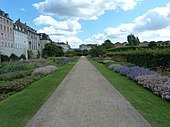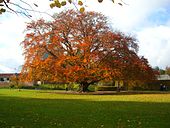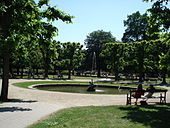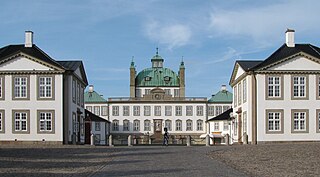
Fredensborg Palace is a palace located on the eastern shore of Lake Esrum in Fredensborg on the island of Zealand (Sjælland) in Denmark. It is the Danish royal family’s spring and autumn residence, and is often the site of important state visits and events in the royal family. It is the most used of the royal family’s residences.
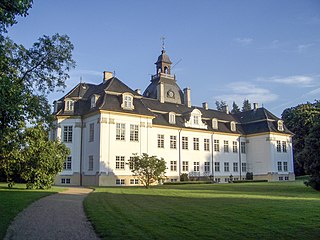
Charlottenlund Palace is a former royal summer residence in Charlottenlund, some 10 km (6 mi) north of central Copenhagen, Denmark. The palace was named after Princess Charlotte Amalie, who was responsible for the construction of the original palace. It was later extended and adapted for Crown Prince Frederick VIII to a design by Ferdinand Meldahl in the early 1880s.

Kongens Nytorv is a public square in Copenhagen, Denmark, centrally located at the end of the pedestrian street Strøget. The largest square of the city, it was laid out by Christian V in 1670 in connection with a major extension of the fortified city, and has an equestrian statue of him at its centre. The initiative moved the centre of the city from the medieval area around Gammeltorv, at that time a muddy medieval marketplace, to a cobbled new square with a garden complex, inspired by the Royal city planning seen in Paris from the early 17th century.
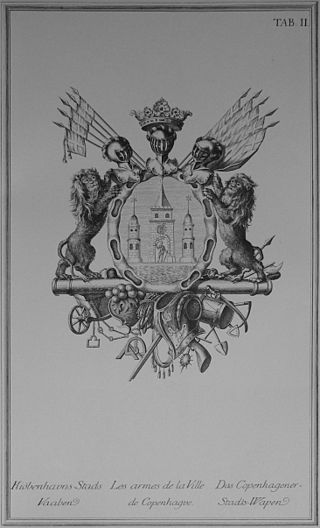
Den Danske Vitruvius is a richly illustrated 18th-century architectural work on Danish monumental buildings of the period, written by the Danish Baroque architect Lauritz de Thurah. It was commissioned by Christian VI in 1735 and published in two volumes between 1746 and 1749. The title refers to the Roman architect and engineer Vitruvius, who published De architectura in the 1st century AD, an authoritative treatise on the architecture of the time. The direct inspiration for de Thurah's Den Danske Vitruvius was Colen Campbell's Vitruvius Britannicus.

Rosenborg Barracks, one of two barracks of the Royal Danish Life Guard, is located next to Rosenborg Castle in Copenhagen, Denmark. Its address is Gothersgade but it has a long facade along Øster Voldgade.

Gothersgade is a major street in the City Centre of Copenhagen, Denmark. It extends from Kongens Nytorv to Sortedam Lake, passing Rosenborg Castle and Gardens, Nørreport Station and Copenhagen Botanic Gardens on the way.
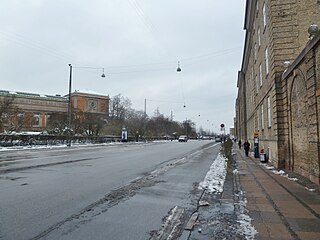
Øster Voldgade, together with Vester Voldgade and Nørre Voldgade, forms a succession of large streets which arches around the central and oldest part of the Zealand side of Copenhagen, Denmark. It runs north-east from Gothersgade at Nørreport Station to Georg Brandes Plads, between the Copenhagen Botanical Gardens and Rosenborg Castle Gardens, and continues straight to a large junction at the southern end of Oslo Plads, near Østerport Station, where it turns into Folke Bernadotte Allé.

Kronprinsessegade is a street in central Copenhagen, Denmark. Noted for its fine Neoclassical houses, it extends from Gothersgade and runs along the southern boundary of Rosenborg Castle Garden, passing Sølvgade and the Nyboder district of old naval barracks before finally joining Øster Voldgade close to Østerport Station. The David Collection, a museum which displays a large collection of Islamic art as well as Danish and European fine and applied arts, is based at No. 30.

Dronningens Tværgade is a street in central Copenhagen, Denmark, which runs from Bredgade to Rosenborg Castle Garden. The street originally formed a link between the King's Garden and the Queen's Garden. With the Odd Fellows Mansion on Bredgade and the central pavilions of the east fringe of the castle garden located at each their end, the street has axial qualities. These are accentuated by the Dronningegården Estate, a Functionalist housing complex from the 1940s, which forms an urban space around the intersection with Adelgade.

Sølvgade Barracks is a former military facility from 1771 located on the corner of Sølvgade and Øster Voldgade in central Copenhagen, Denmark. The barracks closed in 1926 and the large Baroque complex designed by Nicolas-Henri Jardin then served as headquarters for DSB, the Danish state railways, until 2013, when the building was converted into student apartments.

Civiletatens Materialgård is a former storage facility at Frederiksholm Canal in Copenhagen, Denmark. The complex was used for the storing of materials used for the royal palaces but also has a long history as home and work place for sculptors associated with the Royal Danish Academy of Fine Arts. Together with the adjacent Fæstningens Materialgård, its military counterpart, and the Royal Horse Guards Barracks, it forms a cluster of low, yellow-washed buildings alongside Frederiksholm Canal. It now houses the Art Academy's School of Sculptury as well as residences.

Sølvgade is a street in central Copenhagen, Denmark, extending north-west from Borgergade to The Lakes where Fredens Bro connects it to Fredensgade. The section from Kronprinsessegade to Øster Voldgade follows the walled north-eastern margin of Rosenborg Castle Garden and the next section, from Øster Voldgade to the intersection with Farimagsgade, named Sølvtorvet although it is little more than a busy street junction, separates Copenhagen Botanical Garden from Østre Anlæg.
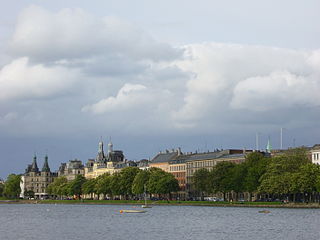
Vester, Nørre and Øster Søgade is a succession of streets along the eastern side of The Lakes in central Copenhagen, Denmark. The streets run from Gammel Kongevej to the south to the beginning of Østerbrogade at Lille Trianglen in the north. Vester Søgade runs from Gammel Kongevej to Gyldenløvesgade, Nørre Søgade runs from Gyldenløvesgade to Dronning Louises Bro, and Øster Søgade from Dronning Louises Bro to Lille Triangel.

Vester, Nørre and Øster Farimagsgade is a succession of streets which together connect the south-western Vesterbro to the northern Østerbro along the periphery of the city centre in Copenhagen, Denmark. A continuation of Reventlowsgade, Vester Farimagsgade extends from Vesterbrogade at Vesterport Station and initially runs along the sunken railway tracks on the left before soon reaching H. C. Andersens Boulevard. It then turns into Nørre Farimagsgade and continues behind Ørsted Park to Gothersgade where it becomes Øster Farimagsgade and proceeds along another green space, the Copenhagen Botanical Garden, passes Sølvtorvet and the neighbourhood of terraced houses known as Kartoffelrækkerne before terminating at Lille Triangel where Østerbrogade begins.

The park of Frederiksborg Castle is located to the north and west of Frederiksborg Castle in Hillerød, Denmark. It consists of a formal Baroque garden and a Romantic landscape garden.

The Lapidarium of Kings is a lapidarium in Copenhagen, Denmark. It exhibits a royal collection of sculptures, natural stone figures and plaster models.

Rigensgade is a street in central Copenhagen, Denmark. It links Sølvgade in the west with Øster Voldgade in the east. An underpass for pedestrians link the beginning of the street with Rosenborg Castle Gardens on the other side of Sølvgade. Notable buildings include the former Garrison Hospital. and the Methodist Jerusalem's Church.
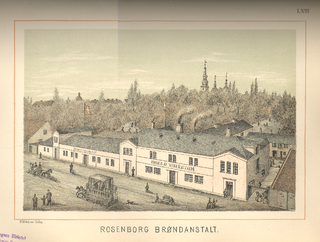
Rosenborg Brøndanstalt was a mineral spa and mineral water factory located in Gothersgade in Copenhagen, Denmark. Rosenborg Brøndanstalt was founded on 23 March 1831 at the initiative of Jonas Collin, medical doctor Ole Bang, and Johan Georg Forchhammer to provide the citizens of Copenhagen with an alternative to visiting spas abroad. First Frederik VI and later Christian VIII contributed to the project by donating a strip of Rosenborg Castle Gardens along Gothersgade. The buildings were built to a design by royal building inspector Jørgen Hansen Koch in 1833.

Thomas Andreas Blom was a Danish master mason, architect and developer who contributed to the rebuilding of Copenhagen in the years after the Copenhagen Fire of 1795 and the Battle of Copenhagen in 1807. He initially worked in a partnership with his mother and three brothers as Bloms Enke & Sønner, constructing approximately one building per year between 1799 and 1808. After being licensed as a master mason in 1810, he continued the work independently. Most of his surviving buildings are listed on the Danish registry of protected buildings and places. He was also active in Copenhagen Fire Corps, reaching the rank of deputy fire chief. He was a driving force behind the foundation of Håndværkerstiftelsen as a charity providing affordable accommodation for old craftsmen and their widows in difficult circumstances.












